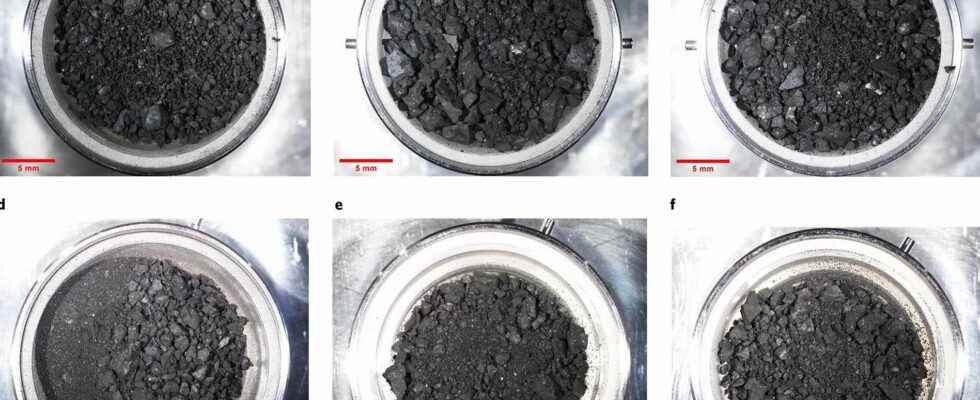You will also be interested
[EN VIDÉO] Osiris-Rex says goodbye to Bennu The mission of Osiris-Rex (Nasa) was to collect rock samples from the surface of the near-Earth asteroid Bennu and bring them back to Earth. The first objective was fulfilled in October 2020. For the second, it will be necessary to wait until September 2023. But the machine returned to Earth on Monday May 10, 2021. Back in video on this incredible scientific and technological adventure. (in English) © Goddard Space Flight Center, NASA
It’s the next distant mission after Tianwen-1the first Mars exploration underway. One year after the landing of the very first Chinese rover – Zhurong – on the Red Planet, China is aiming for a new, extremely complex technical objective: automated sample collection. So far, China’s space agency, CNSA, took samples from the Moon (end of 2020). It is the only mission of this kind made by China, but it is already spectacular.
A type of asteroid never explored
Following Tianwen-1, the Tianwen-2 mission will depart in 2025 for theasteroid Kamo’oalewa (a.k.a 2016 HO3), the diameter of which reaches only 40 meters. It’s an asteroid NEOwhose studies of its composition and sound orbit suggest that he would be a former ejecta of the Moon. This is called a quasi-satellite of the Earth: it revolves both around the Sun but also around our Planet – in a very elliptical way.
Kamo’oalewa is known as the most stable of Earth’s quasi-satellites. Indeed, these objects are on fragile tracks and can then branch off under the effect of gravitation. The asteroid is expected to remain in its orbit for another nearly 300 years. Never has an object of this kind been approached. The collection of samples by Tianwen-2 would allow us to know more about the quasi-satellites of the Earth, and their origin.
Kamo’oalewa, also called 2016 H03, is a quasi-satellite of Earth. © JPL, NASA, YouTube
The collection and return to Earth of the samples from Kamo’oalewa should be completed fairly quickly. The journey to reach the asteroid will only take a few months. The CNSA will use the technique of touch and go (landed – picked up – left), previously used by Japanese missions Hayabusa or Osiris-Rex of the Nasa. Only the anchoring technique is different: Tianwen-2 will deploy four arms robotics which will screw to the surface. This will prevent the probe from leaving the surface during the sampling because given its size, the gravity of the asteroid can be considered as zero. The CNSA did not specify how much Tianwen-2 samples are supposed to bring back to Earth.
Once the sampling is complete, the probe will return to bring the samples back to Earth. She will drop them in a capsule protected by a heat shield to pass through our atmospherewhich will land under parachute in the desert from Inner Mongolia two to three years after liftoff in 2025. But at this point, the Tianwen-2 mission will not be completed. She has a second destination.
A dual mission
After the Kamo’oalewa samples are dropped on Earth, Tianwen-2 will continue on its way towards object 311P/Panstarrs. The journey will last seven years. When it passes Earth, Tianwen-2 will use its gravity to accelerate and thus save fuel. Once arrived at 311P/Panstarrs, the probe will tell us all the information about this strange object. First classified in the category of cometsit is in fact an “active asteroid”, that is to say that it combines the properties of both an asteroid and a comet.
Equipped with cameras and spectrometers, the probe will analyze its chemical composition. With the study of this kind of object, the CNSA hopes to provide some answers to the question of the origin of water in our Solar system. In particular, there will be Russian participation in this mission. Responding to a call for tenders from the CNSA, the Russian space agency will supply a detector of solar wind.
China conquering the solar system
On May 13, the CNSA announcement that the mission leaves the conceptualization phase and moves into the development phase. We will first build the engineering models of the various elements of Tianwen-2 for testing before building the flight models for takeoff in 2025.
The CNSA has already defined which will be the following missions in the Tianwen program. After returning asteroid samples with Tianwen-2, the agency will tackle the extreme difficulty of returning Martian samples with Tianwen-3. It will be an all-in-one mission, Conversely from the program Mars Sample Return of NASA and theESA. Lift-off is scheduled for 2028. The Tianwen-1 probe, currently in orbit around Mars, continues its surface mapping work to find the best sampling site.
Finally, the Tianwen-4 mission will aim Jupiter. The probe should also split in two to study Jupiter but also its closest volcanic moon Io. Other missions are under study, in particular to visit Uranus and Neptuneand even leave the solar system !
Interested in what you just read?
